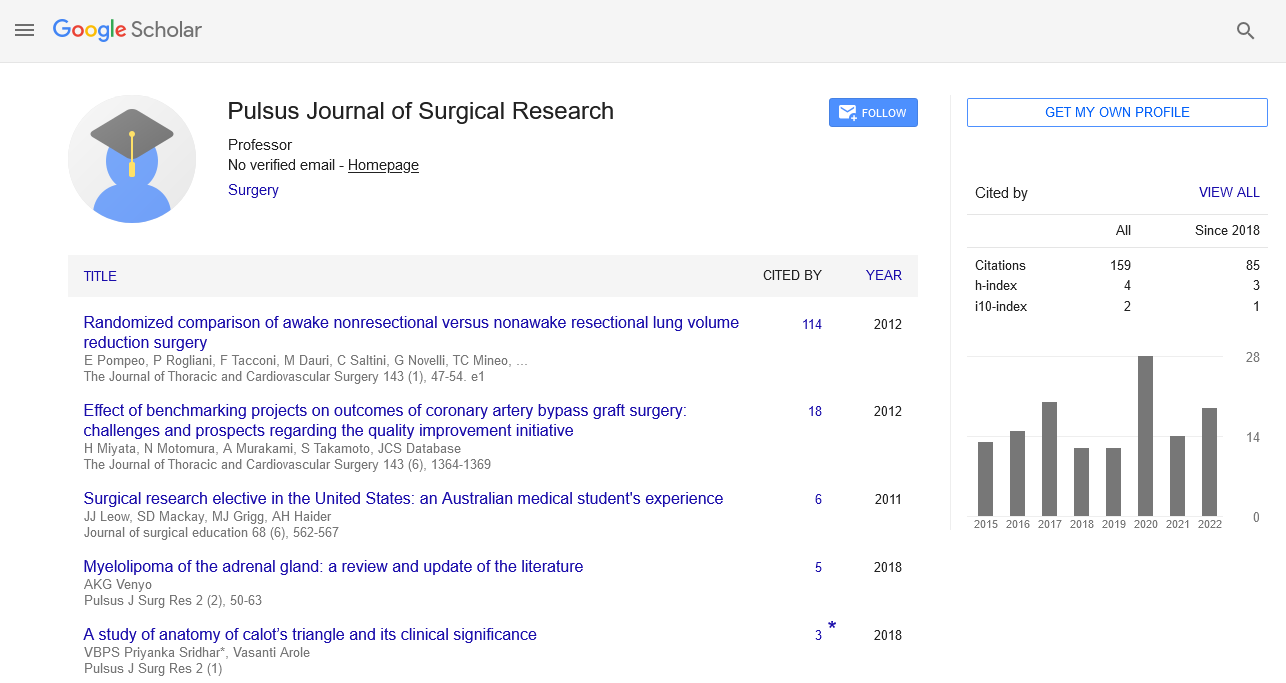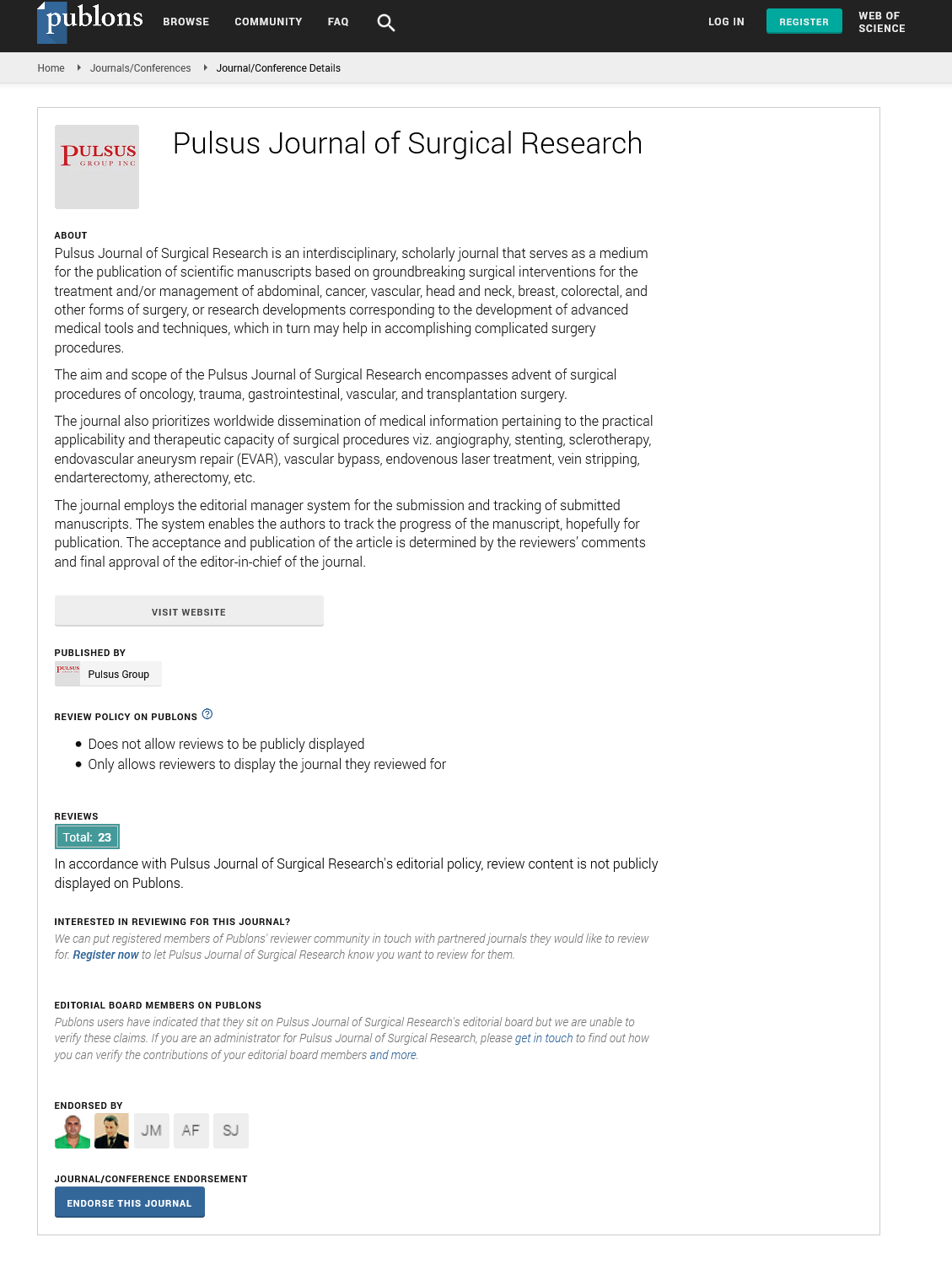An international registry-based case-control study on surgical management of breast cancer liver
Received: 03-Jun-2022, Manuscript No. pulpjsr- 22-5676; Editor assigned: 06-Jun-2022, Pre QC No. pulpjsr- 22-5676 (PQ); Accepted Date: Jun 26, 2022; Reviewed: 18-Jun-2022 QC No. pulpjsr- 22-5676 (Q); Revised: 24-Jun-2022, Manuscript No. pulpjsr- 22-5676 (R); Published: 30-Jun-2022
Citation: Shree S . An international registry-based case-control study on surgical management of breast cancer liver. J surg Res. 2022; 6(3):43-45.
This open-access article is distributed under the terms of the Creative Commons Attribution Non-Commercial License (CC BY-NC) (http://creativecommons.org/licenses/by-nc/4.0/), which permits reuse, distribution and reproduction of the article, provided that the original work is properly cited and the reuse is restricted to noncommercial purposes. For commercial reuse, contact reprints@pulsus.com
Abstract
For breast cancer liver metastases, it is still uncertain whether liver resection or ablation is beneficial. The study's objectives were to evaluate surgical vs systemic treatment regimens and determine survival following isolated breast cancer liver metastases in national cohorts. Surgery for breast cancer liver metastases is safe and may improve survival in certain patients, but to prevent selection bias, prospective trials are necessary. Metastases to the liver from breast cancer National Breast Cancer RegisterNBCRMetastatic Breast Cancer Swedish Registry for Liver and Bile Duct Cancer.
Key Words
Hepatobiliary; Surgical care, Oncology, Brest cancer, Vascular surgery.
Introduction
Each year, 1400 patients in Sweden and 522 000 people worldwide Elose their lives to metastatic breast cancer. In 5% of metastatic breast cancer patients, isolated breast cancer liver metastases are discovered. The prognosis for patients with breast cancer liver metastases remains poor, with a median survival of only two to three years, despite improvements in breast cancer treatment generally. In the current management of breast cancer liver metastases, the function of liver resection and ablation is yet unknown. If liver surgery or ablation is utilized for BCLM together with systemic medication, several case studies suggest that the patient will live longer. Furthermore, these research and review papers demonstrated the safety of liver surgery for breast cancer liver metastases. Single metastases, liver-only metastases, estrogen-positive breast cancer, non-triple-negative tumors, and a favorable response to systemic therapy are among the prognostic markers that have been identified as being effective for identifying individuals who are candidates for surgery. Liver surgery could postpone or stop systemic therapy, according to those who oppose liver resection and ablation for breast cancer liver metastases, who also claim that the published research has a low degree of evidence. The most recent European guidelines for treating advanced breast cancer do not yet call for randomized clinical trials, yet they are necessary [1-3]. The purpose of this study is to prepare for such a prospective experiment by examining the available nationwide retrospective data. There is a danger of selection bias inherent in published case series because there are often few individuals included who receive treatment at a single institution. There are just three papers with a control group of patients receiving only systemic therapy, and these indicate inconsistent findings about the use of liver resection. Patients who had surgery are compared to a control group receiving just systemic treatment in this countrywide registry-based study. The main goal was to determine if patients who underwent liver resection or ablation for BCLM would benefit in terms of survival. Our theory is that BCLM patients will live longer if they receive local treatment. Studying the safety and survival predictive variables in the surgically treated group was one of the secondary objectives. To find patients with BCLM, two national cancer registries—the National Breast Cancer Register (NBCR) and the Swedish registry for cancer in the liver and bile ducts (SweLiv)—were used. Incorporated in 2009, SweLiv covers all primary liver tumors in addition to all liver ablations and resections for primary malignancies and/or metastatic illness. Established in 2008, the NBCR. Although both registries have good inclusion rates, NBCR has a lower inclusion rate in the follow-up form, which is where metachronous metastases are reported. Breast cancer history and a BCLM score of one to five were prerequisites for inclusion. Since it was impossible to determine which breast cancer metastasized, investigations of survival and prognostic variables could not be conducted on patients with bilateral or recurring breast cancer. Extrahepatic metastases in patients were disqualified. There were included all molecular subtypes of breast cancer. The NBCR was used to identify patients who had BCLM. Imaging reports from the three months prior to the diagnosis of liver metastasis were examined in order to create a reliable control group, and patients with extrahepatic illness or more than five BCLM were eliminated. The following data were obtained from NBCR and patient records: the date of the primary tumor and BCLM diagnosis, age at BCLM diagnosis, primary tumor size, axillary nodal status, estrogen and progesterone hormonal receptor status, human epidermal growth factor-2 (HER2) amplification, vascular ingrowth, histological grade, and adjuvant oncological treatment. The SweLiv registry was used to gather data on the number of metastases, size of the largest metastasis, neoadjuvant treatment, and age at surgery, complications, and 90-day mortality. After surgery, there was no mortality for 90 days. Surgery patients were included in a postoperative complication registry. Bile leakage, intestinal blockage, ascites, wound infection, another small bowel issue, and one additional unidentified complication were the complications. The registry didn't include a scale for assessing the seriousness of the issues. Log-rank test and a KaplanMeier plot were used to analyze survival data. Both from the date of breast cancer diagnosis and the date of liver metastases, there was a considerably higher survival rate in the surgical cohort. In both the surgery and control cohorts, there were 136 months of median survival after a breast cancer diagnosis. A prospective trial is recommended to eliminate selection bias, although our analysis of a large national cohort demonstrates that surgical therapy of isolated oligo metastatic BCLM is uncommon but safe and may extend survival in certain patients. The patients were chosen from well-covered national registries, which is the study's strength. While liver surgery in Sweden is concentrated in six centers, both surgical and systemic treatment for breast cancer was provided in various centers. The majority of earlier research on BCLM surgery has been conducted as single-center case series without a control group. Only surgical cohorts from a single center were included in published case-control studies, and the patients were followed for extended periods of time with changing systemic treatment plans. Sweden's systemic breast cancer treatment is largely standardized because it is carried out in accordance with federal regulations. Modern systemic treatment regimens, including anti-Her2 medication when necessary, were used to treat the patients during the course of the last ten years. The nationwide data had a complication rate comparable to earlier studies on liver surgery, and there was no 90-day mortality. It is plausible to conclude that liver surgery for BCLM is secure when carried out in facilities with experience in this area [4-7]. Despite receiving widespread press, this retrospective study's tiny sample size is a flaw. According to the coverage of the SweLiv liver registry, surgical therapy for BCLM is uncommon. Additionally, only 33 representative controls could be found despite a sizable initial source of patients for the control cohort. The majority of rejected individuals either had numerous liver metastases, extrahepatic illness, or invalid imaging. Since distant metastases are reported on a follow-up form in NBCR with low coverage in some regions, the actual incidence of oligo metastatic BCLM in Sweden is greater. It can be assumed that people could be eligible for liver surgery for BCLM each year based on the frequency of advanced breast cancer in Sweden and the proportion acquiring isolated liver metastases. As is demonstrated below, just five people have surgery annually, but if the procedure is found to be effective, more patients may be offered it. Despite the growth in liver surgery for various reasons, there was no trend toward an increase in BCLM surgeries during the study period. Due to the long-term stability of bone metastases, patients with BCLM and certain conditions may be candidates for surgery. This may lead to an even greater number of people who might benefit from surgery. The lack of evidence of enhanced survival may help to explain why so few individuals with BCLM get liver surgery. There is currently no active surveillance of breast cancer patients to look for potentially operable liver metastases because of this knowledge gap. A good predictive factor for survival following BCLM surgery in the current sample was HER2 gene amplification. Other prognostic variables, such as the presence of an estrogen receptor, solitary metastasis, and the absence of vascular invasion, have been reported in earlier investigations. The disparity in these findings may be explained by the study's limited sample size. Although HER2 gene overexpression is typically associated with a worse prognosis, an effective anti-Her2 targeted therapy for this subgroup may account for why HER2 emerges as a favorable prognostic factor in this study. The blatant selection bias risk is a limitation of this study. The greater number of estrogen receptor-positive tumors in the surgical group and the longer disease-free period between breast cancer diagnosis and BCLM can both be seen as evidence of selection bias. Comorbidity is a factor that may have influenced a patient's decision to have surgery, but the registries do not have information on it. In a multivariate study that took hormone receptor status and HER2 amplification into account, the relevance of surgical treatment—which is a positive predictive factor in a univariate analysis—was lost. This might be because the cohorts were smaller and the surgical cohort had more original tumors that were estrogen positive. Therefore, despite the fact that this study's findings were consistent across the country, it is still too early to advise BCLM patients to undergo surgery outside of prospective studies, and any potential survival advantage in the surgical sample should be read with care.
References
- Torre LA, Siegel RL, Ward EM, et al. Global Cancer Incidence and Mortality Rates and Trends—an UpdateGlobal Cancer Rates and Trends—an Update. Cancer epidemiology, biomarkers & prevention. 2016; 25(1):16-27.
- Elsberger B, Roxburgh CS, Horgan PG. Is there a role for surgical resections of hepatic breast cancer metastases? Hepato-gastroenterology. 2014; 61(129):181-6.
- Margonis GA, Buettner S, Sasaki K, et al., The role of liver-directed surgery in patients with hepatic metastasis from primary breast cancer: a multi-institutional analysis. HPB. 2016; 18(8):700-5.
- Chen W, Zheng R, Zhang S, et al. Report of incidence and mortality in China cancer registries, 2009. Chin J Cancer Res. 2013; 25(1):10.
- Polyak K, Vogt PK. Progress in breast cancer research. Proceedings of the National Academy of Sciences. 2012; 109(8):2715-7.
- Pandey V, Kumar V. Breast Cancer Care-It’s Time to Rethink and Redesign. J Clin Exp Pathol. 2014; 4:e118.
- Malhotra R, Shah KB, Chawla R, et al. Tolerability and biological effects of long-acting octreotide in patients with continuous flow left ventricular assist devices. ASAIO Journal. 2017; 63(3):367-70.






